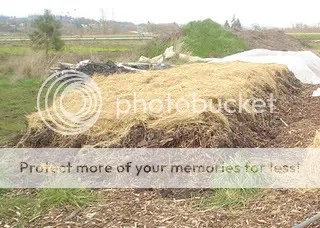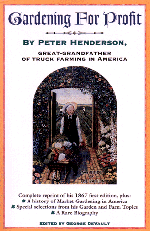Notes based on Gardening for Profit (Chapter 9) by Peter Henderson.
Hotbeds are something we don’t see a lot of, despite their simplicity and usefulness. The idea is that compost generates heat, and seeds need heat to germinate. So why not put seeds directly on the compost pile (the “hot bed”) and coax those little buggers into making their debut a little early in the season? Henderson was doing this in the 1800s, and the logic still applies today:

This is a freshly made hotbed at Singing Pig Farm. It’s about 2 feet tall, 8 feet wide, and 40 feet long. (Disclaimer: I’m terrible at judging dimensions, so give or take about 20 feet on the width and length.) It’s topped with a layer of straw to level the surface and provide additional insulation. Under the straw is a rotting pile of leaves and grass clippings, courtesy of a landscaping company that was happy to get rid of it. The temperature in the pile when it was formed was 105 degrees Fahrenheit.
Henderson’s hotbeds were a little different. He made an excavation that was 2.5′ deep, 6′ wide, and 60′ long. The lengths were bordered by wooden boards: one was 12″ tall and the other was 16″ tall so that when he rested a glass panel on top of them, it was at an angle. That way, the rain would run off and the sunlight would enter more easily. The boards were nailed to posts for support.
For the compost, he’d mix fresh horse manure with half its bulk in leaves and make a big heap. When steam began to sneak out a few days later, he’d turn it over. When it generated steam again a few days later, he transferred the material to the hotbed, filling the 2.5′ excavation. Then he’d put the sashes on until the temperature in there reached 100 degrees, after which he cracked open the sashes until it got down to 90 degrees. Finally, he added 6-8″ of soil and planted either seeds or transplants, covering them with the sashes once more.
This was probably what worked best for him, but it doesn’t have to be that complicated. You can put flats right on any compost pile, as long as you have a flat, even surface. You could even throw 6″ of soil on there and plant the seeds directly. It’s definitely a good idea to cover the seedlings to retain heat and protect them from the elements:

The plastic covering here is temporary–later it’ll be used to make a hoophouse that covers the entire pile, but for now it gets the job done. The straw is optional, but it makes for a more even surface, and it helps if you need to walk on the pile to get the flats on (sinking into compost is not pleasant). A pile like this can be made quickly with a tractor bucket, or with a wheelbarrow and a shovel (if you’re feeling masochistic).
When working with hotbeds, your thermometer is your best friend. A soil thermometer is good, but a compost thermometer is even better because it records higher temperatures and can give you a better idea of what your compost is doing. Check the soil and compost temperatures daily and write them down (if you have a bad short-term memory like I do). Henderson recommends an air temperature range of 55-65 degrees F. at night, and 70-80 degrees F. during the day.
Depending on what your compost heap consists of, and how you prepped it, it might heat up fast and then cool down fast. Ideally, you want the heat to stretch out long enough so that your seedlings can thrive, rather than come and go in one big spike. If the compost itself doesn’t get hot at all, it might be spent. Try adding fresh compost to the top or, if you can, to the center. Learning more about compost will help–decomposition happens in cycles, and by controlling what you put into the compost and how you handle it, you can influence those cycles so that the right amount of heat reaches your plants at the right time. I’ve heard good things about Organic Gardener’s Composting by Steve Solomon (read this notice before clicking on the link) .
If you have any experience with hotbeds, or are going to try them this season, please share your thoughts!

 Back to home page
Back to home page

 Save this page on Del.icio.us
Save this page on Del.icio.us
Nita said
We’ve used hotbeds in the past for seed starting. Horse manure heated up the fastest and cooled down the fastest, we were able to keep the temperature the steadiest with cow manure.
I’m cheating now using a heat mat, but may go back to the hotbed method, to save electricity.
I look forward to more posts. Thanks
Sue said
I used to have a simple cold frame made with old windows from the dump and cement blocks gleaned from here and there. It was deep so I used to fill it with horse manure and old chicken bedding and snug my seed flats down into it. I was able to grow a lot in there and have them stay toasty warm. Early spring mornings you could see the steam rising.
Jai C J Marks said
A rodent free application for this same idea was tested by myself and Alden to great length at Tree of Life Raw Food center in the SNOW ! Taking trash wood and last years poly ,making little green houses ,with doors and wire mesh for extra heat and easy stacking in off season ( heat over 100f ). If you want more info hit me up at Tribe.net or My Space by Jai C J Marks. For disease control and mold suppression EM 1 was activated and added in a 1 to 10,000 ratio . This bread healthy pro biotic plants starts with an easy vent system . Much love to this site just found ya and it makes this displaced Cajun SMILE .